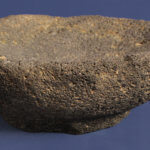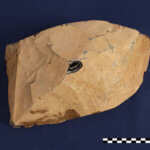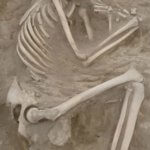In 2013, during the first season of the Armenian-Polish Archaeological Mission to Metsamor the team carried out mainly reconnaissance tasks in order to attempt to reconstruct the general chronology of the site and determine the best location within the limits of the settlement for further in-depth investigation. At the beginning of October, four separate test trenches were opened. The first was marked out inside the fortress on the north-western slope of Mets Blur hill, the main citadel of the settlement. The second was placed near the outer face of the northern fortification wall, while the remaining two were opened on a terrace protruding from the northern slope of the hill. By the end of the first week of the fieldwork, we unearthed a large quantity of pottery sherds while digging through demolition rubble, an arduous task that required the movement of numerous hefty stones. The first success came during the second week in the form of a cobbled pavement dated to the Achaemenid period. The construction was found in one of the test trenches set on the northern terrace. Shortly afterwards, the same square yielded the second major discovery, the ruins of a pre-Urartian oval stone structure. The area inside the building was covered by ashes and burned wooden beams, on the floor we found broken fragments of six big pithoi, a type of large storage vessel. It was clear that the demolition of the structure was the consequence of a sudden event, most probably an assault. Near the north-eastern corner of the same test trench a simple burial was found. It contained a single skeleton belonging to a woman who lived and died in the Roman period, sometimes during the 2nd century A.D. The other examined areas produced similarly interesting results. The trench, that was opened on the slope of the citadel inside the fortress, yielded the earliest archaeological finds. At the bottom of the excavated area the team uncovered a small basalt bowl dated to the late 3rd millennium B.C. Among the finds were also four big obsidian cores dated to the late 2nd millennium B.C. At this part of the mound we could observe the stratigraphic sequence of human occupation stretching across millennia from the Early Bronze Age (4th millennium BC) until Medieval times (14th century A.D.). The other test trench, situated at the northern fortification wall, supplied us with additional information on the building phases of the defensive structure. The excavation work clearly showed that the original wall was reconstructed many times during the period of its existence.
The experience gained and field observations made during the 2013 season were crucial in aiding us to choose the ideal target for further investigation. After analyzing the obtained data and carefully considering our options we selected the northern terrace for in-depth examination. The area held the possibility to reveal more information about the little studied domestic lower-town, and since it was untouched by previous excavations an undisturbed stratigraphy seemed more likely than in any other part of the settlement.
Team members: Prof. Ashot Piliposyan, Dr. Krzysztof Jakubiak, Miqayel Badalyan, Artavazd Zaqyan, Tigran Zaqyan, Joanna Dzik, Mateusz Iskra, Marcin Okniński, Agata Migdalska, Marek Truszkowski and Martin Malata.
Back to publications




